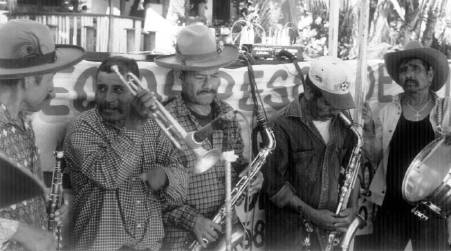

Most of the chilenas we hear are performed by a banda, A major change in Oaxaca's musical style came about with the arrival of military bands at the end of the XVIII century.
 Oaxacans lapped up big brass horns, trumpets and drums. Songs and marches
were rewritten and traditional instruments incorporated to give Oaxacan
band music its own distinctive flavor. Almost every village, no matter how
cash strapped, has its own band that performs at any and every given
opportunity, from fiestas to funerals.
Oaxacans lapped up big brass horns, trumpets and drums. Songs and marches
were rewritten and traditional instruments incorporated to give Oaxacan
band music its own distinctive flavor. Almost every village, no matter how
cash strapped, has its own band that performs at any and every given
opportunity, from fiestas to funerals.
Chilena dances are part of the rich folkloric heritage of the Mixtec, Amuzgos and Chatino Indians of the state. Couples always dance apart, pañuelo, or handkerchief, held high in the right hand.
Chilena songs are built on an eight-syllable structure, preceded or followed by a chorus that alternates with sections that are purely instrumental.
The lyrics speak of every day life, referring to love, women, elements of nature such as crops or animals, or paeans to the hometown. Some of the lyrics are quite risque, making extensive reference to the shortcomings of partners and can really get a crowd going.
As with many other aspects of the culture in this region, chilenas are a mixture of native Indian, Spanish and African elements. Some experts believe that the predecessor to the chilena was the marinera peruana, a music genre related to the traditional cueca of Peru and Chile.
Spanish galleons often carried African slaves on board their vessels as they sailed along the Pacific coast between Chile and Mexico.
One theory holds that immigrants from Chile, seeking their luck in the Gold Rush, brought the music with them when some settled - or were shipwrecked - in Mexico on their way to California. And then there are some advocates from the town of Sola de Vega who claim that the chilena is a purely indigenous creation and the word comes from the Zapotec chijena, which means the sound made by instruments.
Every community has its own style of chilena, Some call it son, fandango or jarabe, The attractive Mixteca market town of Jamiltepec, which bills itself as the cradle of the chilenas, hosts its annual Chilena Festival in April.
Villa Tututepec is one of the oldest established settlements on the coast, whose rulers dominated the region for centuries until the Spanish Conquest. Their fandango is played by a band comprising 2 guitars, a violin, cajón, charasco, cantera (all simple percussion instruments made from a wooden box, ass' jaw and a pot, respectively) and a vocalist.
In Pinotepa Nacional there's a festival honoring the man who wrote the
most famous chilena of all time, Pinotepa, Alvaro Carrillo. (See more on
this remarkable costeño on Page 20.)